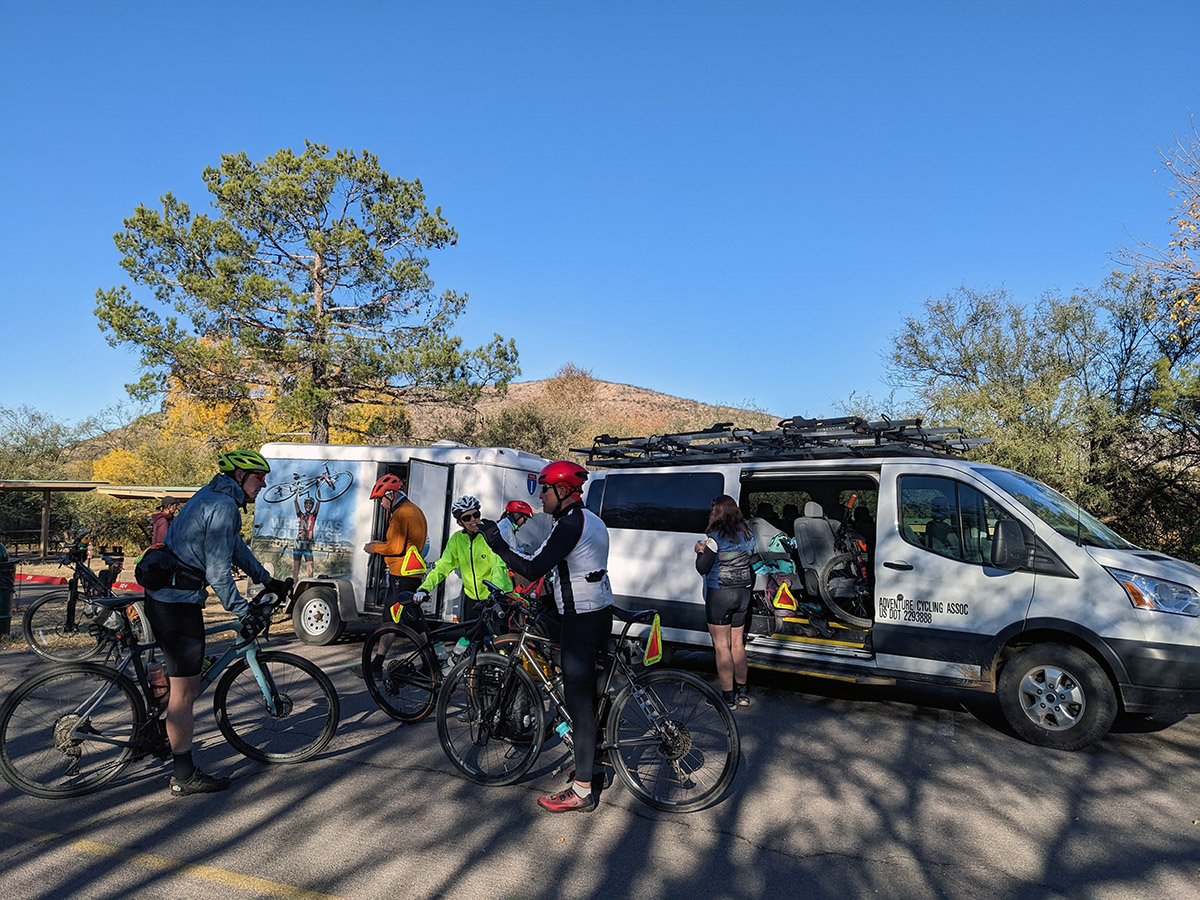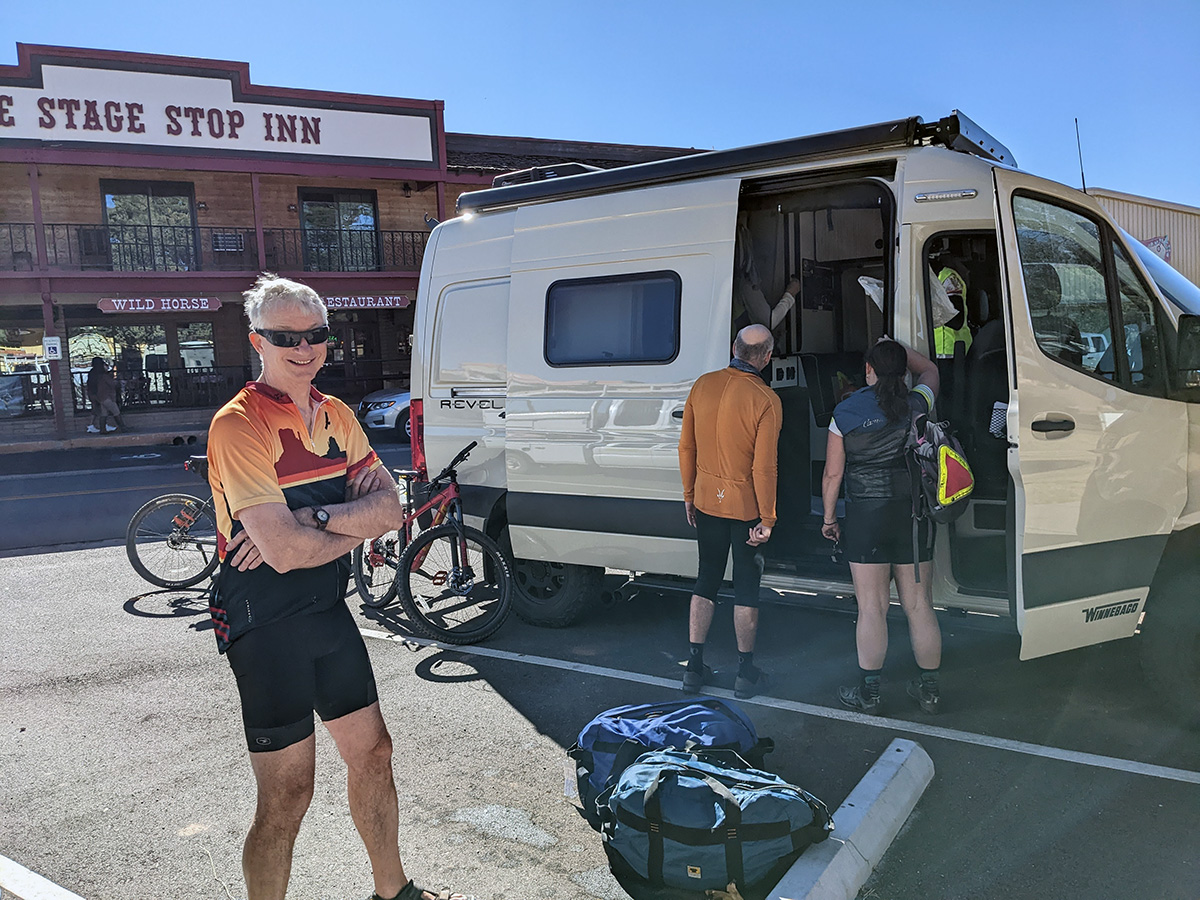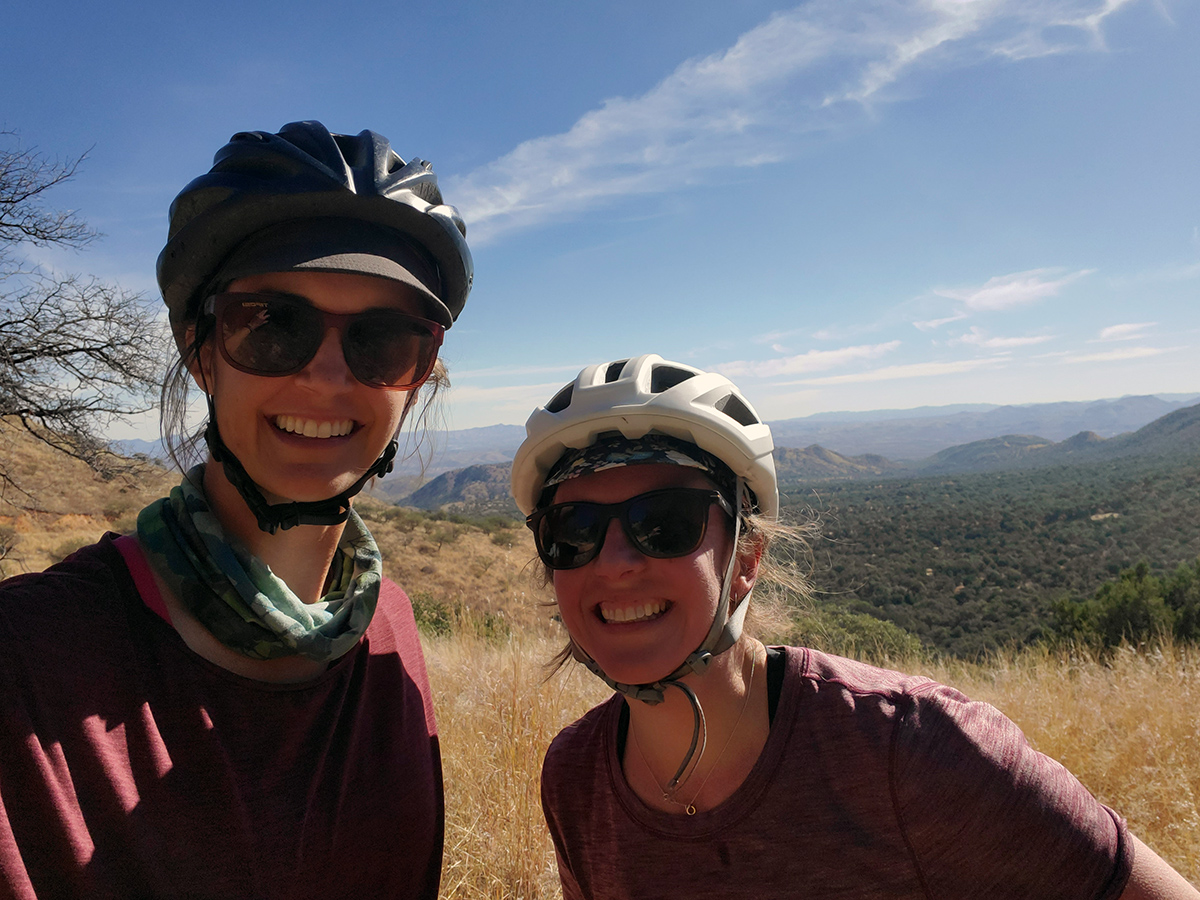My First Van-Supported Gravel Tour
Drawn by the promise of sunshine, scenic gravel, and 65 degrees in November, Amelia and I hopped on a plane headed for Tucson, Arizona. We cross our fingers that our boxed bikes would be gently handled by the Delta staff and flew out of the clouds and south across the desert landscapes, Amelia pointing out the San Raphael Swell and the Grand Canyon below. We were destined for our first Adventure Cycling van-supported Guided Tour, called Patagonia AZ Gravel, just south of Tucson.
Amelia and I have been on a few cycling adventures together, always off-road, over remote mountain ranges, and unsupported far from cell service. With loads of planning, we knew the terrain, route, and services for each day. We had to. But life had given me a few lemons. A four-day, van-supported guided tour — where the leaders told us where to go each day and toted our gear in the van — was our golden ticket. At the same time, a gravel tour lent us the treats we desired in a bike trip: rural dirt, scenic tent camping, mountain passes, and abundant wildlife.
When we met our leaders, Joe and Denny, Amelia and I were frantically assembling our bikes. While Delta handled our bikes with care, the airline employees believed our bikes needed to see Oakland and L.A. before finally arriving in Tucson. Luckily, Joe and Denny waved our apologies away, helped us when they could and cheered encouragement when needed — the sign of a good tour to come. Finally assembled, we were ready to meet up with the other tour participants and learn about the logistics of our tour. And we were very much looking forward to someone else handling the logistics.

Although the other participants were twenty years our senior with many more miles under their belts, it was reassuring to see the assortment of bikes everyone brought. Some were full carbon, drop bar gravel bikes. Others chose a more comfortable, albeit slower, mountain bike. A few even dared to ride their trusty steel touring bikes, including Joe who admitted that next time he’d bring a bike with wider tires. Amelia and I sported almost matching Kona Roves: steel gravel bikes with 47mm tires. I was glad to have my wider tires, since 90% of the tour traversed various states of gravel — everything from smooth hard pack to washboard, chunky rocks, or sand.
After the group intro meeting, Amelia and I packed our Roves with layers of clothes, sunscreen, two water bottles each, and our lunches and headed out. All that stuff filled my handlebar bag, fanny pack, and a half frame bag. Immediately upon starting, we sighted our first javelina of the trip and then stopped to whiz in some bushes and take off our jackets, as one does at the beginning of every ride.
Day One
Day One featured a 29-mile loop with 1,861 feet of elevation gain. At our highest point, just under 5,500 feet, Amelia and I sat in the shade of a tree and ate our lunches. Sandwiches, mandarins, and good ole potato chips fueled our sunny descent. We stopped to take in the views of surrounding mountains, and, in the washes, we pedaled through canyons of rock and tunnels of cottonwoods sporting orange leaves.

Back in the town of Patagonia at its only hotel, Amelia and I showered, grabbed a beer, and readied ourselves for our first group cooking experience. Adventure Cycling Guided Tours are special in this way (and less expensive for it). Unless you’re on a fully supported tour with catered meals, the participants are split into cooking teams who prep, cook, and lay out appetizers, meals, and desserts for the entire group. For such a short, remote tour, Denny and Joe bought all the ingredients from each group’s proposed menus prior to the tour. Amelia, Kathleen, and I were assigned Day One! Luckily, Denny and Joe made it easy. The hardest part was figuring out the location of everything in the trailer and how to put the flat-top grill together, which Denny and Joe did for us. We made steak fajitas so that the gluten intolerant and lactose averse could assemble their dinners how they liked. Everyone set up their chairs and rallied around us. Group cooking allowed us to get to know each other off the bike and built our group comradery. Less confident cooks were paired with home chefs, and I kid you not, the results were delicious. I never once went hungry.
Day Two
Day Two took us south to Parker Lake. Over the day’s 40 miles and 3,250 feet of elevation gain, we wound uphill through canyons onto a wide valley with tall grasses and sparse trees. Some riders spotted pronghorn antelope, and giant raptors were our overhead companions. After a mid-day water stop at the van, we pedaled within five miles of the U.S.-Mexico border. I suggested to Amelia that we should just keep going and pedal all the way to South America — that’s how pleasant the day was. Instead, we veered back north a bit toward Parker Lake, the last few miles seeming to go on forever and a cold beverage calling my name.

The miles did pass, and I was treated to a ready camp chair and snacks. At camp, I used the van’s bike stand, rags, and tools to adjust my rear derailer and clean my chain. Our campsite was quiet, scenic, and allowed for incredible stargazing and owl listening. Nearly everyone fell asleep by 8 PM.
Day Three
I must admit that I am not the sort to jump out of bed in the morning, excited to tackle the day. A few of the tour participants were eager beavers, and what I liked about gravel touring with Adventure Cycling was the flexibility to be yourself. Despite our leaders’ kind warnings to get going early to ensure a daylight finish to the day’s ride, Amelia and I were nearly always the last ones out of camp each morning, and Day Three was no exception.
Day Three was the most challenging with 55 miles, 4,145 feet of elevation gain, and a few sandy sections. But the challenge was part of the thrill for me. Climbing a mountain pass led to the best views and descents of the trip. A sandy meander through a creek bottom popped us out into a quaint town with a red schoolhouse among towering cottonwoods, wherein Joe waxed poetic about the idyllic scene. Eating our afternoon snacks, we warmed our arms in the sun among squatty trees, seeing no one and hearing no one except the calls of birds and our fellow riders who passed and waved. It was my favorite day. Until we hit pavement.
Unfortunately, the last seven or so miles were along the shoulder of State Highway 82, a well-trafficked two-laner with an okay shoulder. Regardless of the shoulder, it was a shock to be among the bustle of cars, and I was a grouch about it. Amelia pulled me along as she always does. Once at the campsite, a shower, a beer, and a vibrant sunset over Patagonia Lake State Park cured my proverbial saddle sores. On our last night together, our group feasted on chili and chatted around the fire. We may have made it past 8:30 PM before hitting the hay.

Day Four
The last day of the gravel tour was a choose-your-own adventure. Denny offered several riding options to see new territory or revisit the first loop from Patagonia. All of us chose the former, adventurers as we are. After riding back to Patagonia from the State Park, we headed north toward the Alto Ruins, a ghost town first settled in the early 1900s for mining. While I was too tired to make it all the way to the ruins, we passed some beautiful rock spires. On the way back, we stopped for a quick rest at the Paton Center for Hummingbirds, a shady sanctuary for birds and bikers alike. It was the perfect end to a great bicycle adventure.
Overall, the Patagonia AZ Gravel tour was exactly what I was looking for in a guided tour. It was a short, scenic tour with two difficult days and two easier days of riding. The tour leaders were helpful, and one always rode sweep to ensure no one got lost. The van support allowed our route to wander into remote regions and lightened the load on our bikes, making the long days easier. Now I’ve got my eye on the Great Allegheny Passage as my next Adventure Cycling van-supported gravel guided tour.
Nuts and Bolts
How to Get There
Amelia, Kent, and I flew into Tucson and secured a shuttle to Patagonia. Other participants drove to the start of the tour. If we’d needed to, we could’ve rented a car in Tucson and left it at Patagonia’s lone hotel, The Stage Stop Inn. Amelia and I also considered taking a local bus as far to Patagonia as possible and then loading our bikes and riding the rest of the way there but that would have required us to be much more efficient in our packing than a van-supported tour warrants.
Ken’s Shuttle Service runs a shuttle between Tucson and Patagonia. Your tour leader can connect you with Ken if you need this service.

Accommodations
We spent one night at the Stage Stop Inn and two nights camping. The first night of camping was rustic, without facilities beyond a pit toilet and a giant fire ring. But the van toted all the food, water, and comfort we needed, and the group site was quiet, without light pollution or the hum of generators. The second campground had warm showers, flush toilets, and a convenience store. While the campground accommodated many RVs, it was fairly quiet. I wasn’t a huge fan of the bright lights lining the boat ramp next to the tent camping area.
Navigation
Our leaders emailed our group route information two weeks prior to the start of the tour. We used Ride with GPS, a phone app, to navigate the route. Leaders also handed out paper versions on the first day of the tour.
Bikes and Bags
I recommend a bike with tires 45mm or wider to handle the rough and sandy sections of any guided gravel tour. The people who brought their touring bikes mentioned how they wished they’d had something better equipped for the terrain. Whether that bike is a gravel bike, hardtail, or fully rigid mountain bike is up to you!
As someone who lives in the mountains but hates being cold, I tended to pack more layers for each day’s ride than other tour participants. I easily filled a handlebar bag, a half-frame bag, and a large fanny pack with clothes, food, and toiletries. (Thank goodness for chamois butter.) I also carried easily accessible snacks in a feed bag. Other riders got away with less, but everyone carried at least two water bottles, sometimes more.
Communications
Beyond registration information, staff and tour leaders begin emailing participants 60 days prior to the tour start. They wait to send the information until this date to ensure that all the information is as correct as possible, while still giving the participants time to plan all the logistical aspects of their trip. And be sure to read their emails! They’re full of important information, some of which you’ll need to act on prior to the tour.
Logistical information, such as airport shuttle options and a bike shop to which you can ship your bike, as well as the start time of the first meeting, come to each registered participant about 60 days before tour departure as well.
Difficulty
Adventure Cycling considers this a Level 4 on their difficulty scale: “A tour for someone looking to push themselves on their adventure. Average mileage between 45 and 60 miles per day, with a variety of terrain. Longer mileage days will typically have more rolling terrain, while shorter mileage days will have hilly or mountainous terrain. Average daily elevation gain between 2,500 and 45,00 feet per day, with some days possibly exceeding 4,500 feet in elevation gain."

I wouldn’t call myself an avid rider but I’m in decent overall physical condition without many health concerns, so my advice comes from that point of view and is not meant to account for every individual’s experience or health situation. Adventure Cycling’s long weekend gravel tours can be short but punchy. The first day eases you into the tour and the last day eases you out, but the two days in between were long and hard. Each of those two days took me six to eight hours (including stops) to finish. The riding surface varied and at times required a little bit of technical skill to ride. I was pooped by the end of this tour.


